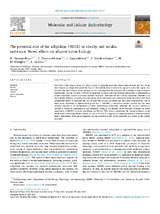Mostrar el registro sencillo del ítem
The potential role of the adipokine HMGB1 in obesity and insulin resistance. Novel effects on adipose tissue biology
| dc.contributor.author | Guzmán Ruiz, R. | |
| dc.contributor.author | Tercero-Alcázar, C. | |
| dc.contributor.author | López-Alcalá, J. | |
| dc.contributor.author | Sánchez Ceinos, Julia | |
| dc.contributor.author | Malagón, María M. | |
| dc.contributor.author | Gordon, Ana | |
| dc.date.accessioned | 2021-11-08T10:41:13Z | |
| dc.date.available | 2021-11-08T10:41:13Z | |
| dc.date.issued | 2021 | |
| dc.identifier.uri | http://hdl.handle.net/10396/22029 | |
| dc.description.abstract | Discovery of the adipose tissue as a major source of signaling molecules almost three decades ago set a novel physiological paradigm that paved the way for the identification of metabolic organs as endocrine organs. Adipocytes, the main adipose tissue cell type, do not only represent the principal site of energy storage in form of triglycerides, but also produce a variety of molecules for short and long distance intercellular communication, named adipokines, which coordinate systemic responses. Although the best known adipokines identified and characterized hitherto are leptin and adiponectin, novel adipokines are continuously being described, what have significantly helped to elucidate the role of adipocyte biology in obesity and associated comorbidities. One of these novel adipokines is high-mobility group box 1 (HMGB1), a ubiquitous nuclear protein that has been recently reported to be dysregulated in obese dysfunctional adipocytes. Although the classical function of HMGB1 is related to inflammation and immunity, acting as an alarmin, novel advances evidence an active implication of HMGB1 in tissue remodeling and fibrosis. This review summarizes the current evidence on the mechanisms controlling HMGB1 release, as well as its role as a regulator of adipocyte function and extracellular matrix remodeling, with special emphasis on the potential of this novel adipokine as a target in the obesity treatment. | es_ES |
| dc.format.mimetype | application/pdf | es_ES |
| dc.language.iso | eng | es_ES |
| dc.publisher | Elsevier | es_ES |
| dc.rights | https://creativecommons.org/licenses/by/4.0/ | es_ES |
| dc.source | Molecular and Cellular Endocrinology 536, 111417 (2021) | es_ES |
| dc.subject | HMGB1 | es_ES |
| dc.subject | Adipocyte | es_ES |
| dc.subject | Obesity | es_ES |
| dc.subject | Insulin resistance | es_ES |
| dc.subject | Fibrosis | es_ES |
| dc.title | The potential role of the adipokine HMGB1 in obesity and insulin resistance. Novel effects on adipose tissue biology | es_ES |
| dc.type | info:eu-repo/semantics/article | es_ES |
| dc.relation.publisherversion | https://doi.org/10.1016/j.mce.2021.111417 | es_ES |
| dc.relation.projectID | Gobierno de España. PID2019-108403RB-I00 | es_ES |
| dc.relation.projectID | Junta de Andalucía. P18-RT-1761 | es_ES |
| dc.relation.projectID | Gobierno de España. RTI2018- 095736-J-I00 | es_ES |
| dc.rights.accessRights | info:eu-repo/semantics/openAccess | es_ES |

